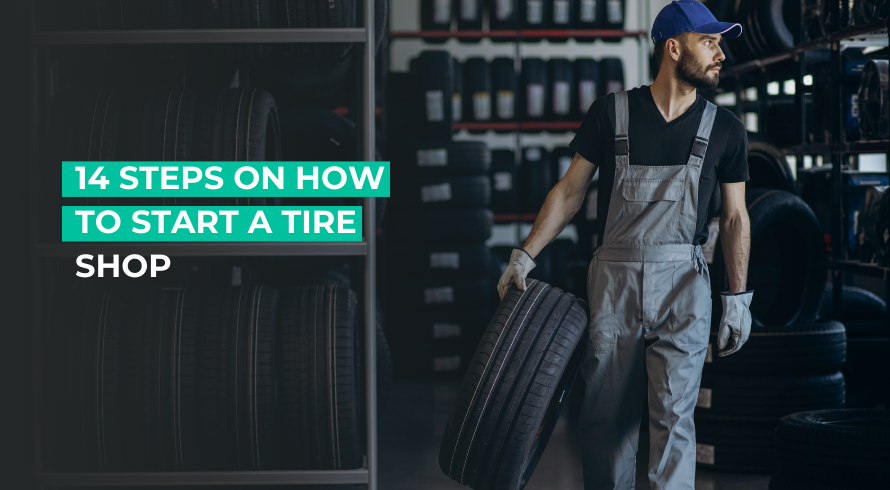Opening a store to sell tires? That’s a pretty smart business decision, especially if one plans well enough for it. Below, you’ll find the steps that will guide you toward setting your tire shop up and running it. The key points in making your tire shop successful include choosing the perfect location and marketing the business effectively.
According to the market research report, the tire shop business is a booming business, with the market expected to reach a CAGR of 2.23% over the years 2025-2033.
Step 1: Decide What Kind of Tire Shop You’ll Open
Before anything else, decide what your shop will offer. Ask yourself questions like:
- Will you focus only on tire sales and installations?
- Will you add auto services like alignments, oil changes, or brake repair?
- Do you want to specialize in high-performance, off-road, or commercial tires?
Step 2: Research the Local Market
The market research is an important step in determining whether you can run a tire shop at all. You will be looking particularly at your local market.
First, determine who your competitors are. Know the brands against which you are set. Check their service provision and understand what makes you a cut above the rest.
Then check if there’s demand for tire services in your area. Get an understanding of the buying patterns of your would-be clients. Try to identify any market gaps that your shop could help fill. This could come in the form of better customer service, better pricing, or uniqueness in product but defining your unique selling proposition is what will lead to success. Here are a couple of examples you could use to give yourself an edge:
- Services that are missing such as there being no shops doing mobile tire repairs.
- Local price survey of tires and general services provided.
- Activities of major tire brands with the near-sightedness of tracking how popular brands rear their heads.
Step 3: Select the Ideal Location
In selecting your tire shop location, consider the following:
- Visibility: A visible location from the road will receive more traffic.
- Accessibility: Consider easy customer accessibility, with sufficient parking space.
- Proximity to suppliers: Proximity to tire suppliers can facilitate deliveries and stock management.
- Proximity to car repair facilities: Getting near car repair facilities would allow you to capture more clients, who will pay you so they can take care of everything at one time.
- Distance from competitors: Take note of the number of competitors around and choose a location with fewer direct competitors if you can. It must be accessible using major roads.
Visibility and ease attract the majority of customers. They won’t drive out of their way to reach your shop. More traffic nearby means more chances for walk-ins and repeat business. Always check local zoning laws before signing a lease to avoid legal issues later. It can differ from state to state, such as California, which has its own set of zoning and licensing rules.
Step 4: Make a Business Plan
Your business plan does not have to be complicated. What it should include are the crucial parts,all budgeting and initial startup costs, projects for revenues, the kind of services you will be offering, hiring, and marketing strategies. Some of the parts that would go into that tire shop business plan include
Executive summary
Place a concise summary of your tire shop, its purpose, and its goals in the executive summary. Defining your goals will guide you on how to make every decision you make thereafter. For instance, determine early on what services you are going to provide so that you purchase the appropriate equipment.
Target market
Identify your target audience and the customers you wish to target. This operation will also involve data regarding your competitors. Note down whatever your competitors are doing. Also, note down similarities and differences. This comparison will assist in differentiating you from those competitors. Finally, be in touch with the industry. Know the trends and how the market is changing.
Budget estimation and funding options
Once the target market is done, you will now think of cost factors: including rent, tools, equipment, insurance, and the first few months’ payroll. Next, you will estimate revenues by determining how many cars you serve daily and how much you’ll earn from each.
Really, before you go doing anything about your tire shop, budget definitions must be top of the mind. Are you going to invest your personal funds into your tire shop? Or do you need to raise some external capital?
Explore your financing options. You could use a combination of personal savings, loans, grants, and investors. Be thoughtful about this process. It will have a major impact on the long-term success of your business.
Operations
Write about your tire shop’s day-to-day operations. Plan out details on staff and inventory management. Consider who you will need now and in the future, such as a tech, receptionist, or service writer. Having something put down on paper aids you in your decision-making process. Taking the time to do this at the beginning of your business will make things easier for you in the long run.
Step 5: Marketing
Define your marketing strategy and how you plan to attract or retain customers. State how much more you will use digital marketing campaigns, traditional marketing campaigns, or the two together as a blend of marketing channels.
How to pull in your first 100 customers through ads, social media, and flyers? Here are some key components of a successful marketing plan:
Website
Provide a professional site where a prospective customer can see the areas of service and the prices along with their contact information. It also appears in search results and gives directions via maps when people look for tire services.
Social Media
Engage the audience on your local customer base with Facebook, Instagram, and Twitter profiles to invite them to special promotions or offers. A quick and cost-effective way to announce your work is by uploading before and after photos onto social media platforms.
Search Engine Optimization (SEO)
Search engine optimization for tire retailers will enhance the visibility of a website within search engines. This is vital in ensuring that it appears more often in local search results.
Local Advertising
Place ads in local newspapers or on local radio stations. Participate in community events to raise awareness. Hand out flyers or offer a grand opening discount to give locals a reason to stop by and check out your services.
Customer testimonials
Encourage satisfied customers to give five-star reviews on your Google Business Profile and Yelp site. That way, you have trust and credibility.
Step 6: Register Your Business
Start with choosing a business structure such as LLC, sole proprietorship, etc. Your structure will affect taxes, liability, and the way in which the business may grow. Next comes the thought of the business name and registration. Pick a name that is easy to remember and fits your brand, and make sure it hasn’t been taken.
File for a business license. Most states or provinces require general business licenses to operate legally. Also, acquire a federal EIN and state tax ID (if in the U.S.). These will be required to hire staff, pay taxes, and open a business banking account. You’ll then use the account for business income, expenses, and payroll. This makes it easier to track how well your shop is doing financially and also helps keep you in compliance with tax regulations.
Stay ahead on all permits and compliance regarding tire shops. A few include the following:
- Fire and safety inspections: Your shop must meet safety codes before exposing it to the public.
- Tire disposal and environmental compliance: Tires cannot go into landfills. Your disposal mechanism will need to be permitted.
- Zoning permits: If your building was not previously a repair shop, you may need approval to operate.
Step 7: Get Business Insurance
It covers you against multiple kinds of risks:
- Injuries to customers: If someone slips in your shop, then insurance keeps you from paying out of pocket.
- Employee accidents: Tire shops tend to be unsafe; worker compensation coverage is a boon for your business.
- Damage to equipment: Without coverage, repair or replacement for lifts and machines can be costly.
- General liability: Covers other legal or property claims on the shop’s behalf.
Step 8: Organize Your Store Layout
An excellent tire shop layout works toward three objectives: welcoming customers, managing a streamlined tire inventory, and opening bays. The clear waiting area ensures comfort to customers in waiting. Organized tire storage saves space and reduces mishaps. Open bays with space for lifts and equipment service more cars in a timely fashion.
Step 9: Buy Equipment and Supplies
Here is a final list of the necessary equipment and machinery for your shop:
- Tire changers: The detachable and installable wheels are done by a tire changer. You will require a tire changer for different sizes and types of wheels, ranging from passenger wheels to larger commercial wheels.
- Wheel balancers: Balancing of wheels is an important aspect of attaining a smooth and secure ride. An efficient wheel balance loads the weight for the tire to rim assembly. There are three types of wheel balancer: static, dynamic, and bubble. You can have all these for your tire business.
- Alignment machines: The revenue from supplying wheel alignment can be quite significant. The capability that you will need is how various makes and models of cars will accommodate your alignment system, which will require that you meet some varied customer needs. You should pay special attention to the software and precision sensors utilized, as they should enable you to achieve precise and efficient adjustments of the alignments.
- Tire repair tools: You will also require tire repair tools in your tire shop. The most critical tools to be incorporated are Tire Plugs and Tire Patches. Plug kits for tires include equipment that is used to insert tire plugs in punctured tires, whereas patch kits are used to repair extensive punctures or cuts in the tire.
Good-quality tire shop equipment will ensure your customers’ safety and satisfaction, which is paramount for maintaining a good reputation. Acquiring these tools is included in the initial investment for your tire shop.
Step 10: Set the Dynamics of Your Inventory
A tire shop cannot survive without being loaded with tires. Develop a diversity in tire inventory that would cater to all needs of your intended market. Include a large variety of brands, sizes, and types of tires such as all-season tires, winter tires, summer tires, performance tires, off-road tires, and commercial truck tires.
This, of course, will give customers what they want, but it will enable you to compete against the giants in the market as well. Know what you have so that you can avoid delays and customer frustration. This also helps to ensure reordering faster-moving commodities since popular tire sizes go quickly. Set alerts or minimums so you don’t run out. Lastly, managing vendor relationships by tracking orders and returns helps you negotiate better prices and delivery times.
Step 11: Hiring and Training Personnel
Obtaining skilled and knowledgeable staff is paramount when striving at keeping top-notch service for your customers. General aspects to look for among technicians would include experience in tire installation, balancing, as well as repair. Training programs are investments that will help your employees keep updated on the latest industry trends and technologies.
Get started by hiring one or two certified tire technicians. They are the professionals who mount, balance, and install tires with safety. A possible hire is a front counter or service advisor. She or he could take walk-ins, payments, and keep the day organized.
Provide basic training on tire installation and balancing. A consistent and safe work means fewer customer complaints or redos. Place emphasis on safety and lift operation practices to protect your team and avoid injuries by sticking to shop safety rules. Customer Service Basics:
A friendly, helpful staff can turn a one-time visit into a loyal customer.
Step 12: Leverage Tire Shop Management Software
Tire shop software such as AutoLeap can assist shop owners in managing business activities smoothly and efficiently. Some of its main features are
- Convert estimates to invoices with just a single click.
- Order crucial parts directly from suppliers and replenish inventory based on part usage patterns. Send reminders and follow-ups to customers to establish stronger relationships.
- Schedule technicians’ calendars and theirs to ensure they’re never overbooked.
- Retrieve repair information, wiring diagrams, and other information from a single source.
Step 13: Track your finances
Keep good financial records from work order estimates through to payment receipts so that you can measure the performance of your tire shop. Accounting software should be able to manage these expenses and revenue with taxes in the range of a month-end close. These reports should be examined regularly for areas that may be improved upon in further informed decision-making for the business.
Step 14: Customer Service
One of the best methods for differentiating your tire shop from others is by providing superior customer service. Pay attention to the following:
- Timeliness: Provide timely service. Minimize wait times. If you have customers coming in with appointments, don’t make them wait so long.
- Pricing transparency: Be transparent with customers about pricing and what they can get done within a specific amount of time. If possible, publish your prices on your own website.
- Politeness: Get your staff trained to be polite, considerate, and responsive to customer needs. Effective staff and good customer service can be all the difference for your tire shop.
Additional attention to detail can ensure that your new business takes off. So let’s see what else you can do before opening up a tire shop!
What Additional Services Should Tire Shops Offer?
Want to earn more from day one? Offer high-margin services like:
Sales of tires
You can have your sale inventory divided between all-season tires, winter tires, or performance types. Tires seem to have a better profit compared to install-only jobs.
Mounting and balancing
Now this is very essential on every set which is sold off, and it’s quite quick when equipped with the right tools.
Repairing tires
Patches and plugs are inexpensive tools but return very high. These are good services for walk-ins or emergencies.
Seasonal tire storage
A good addition to keep customers returning in every season while generating recurring revenue.
Add-ons
Alignments, oil changes, brakes: These services grow the average ticket size and make your shop a one-stop solution for nearly all tire jobs.
TPMS tools
Most newer vehicles equip the driver with a Tire Pressure Monitoring System (TPMS). This system tracks the air pressure in each tire and alerts the driver if one is too low. When installing new tires or rotating them, the TPMS often must be reset to avoid warning lights.
How much do tire shops make annually?
In gross revenue, about $150,000-300,000 gross revenue is earned by most independent tire shops in North America. However, profit margins vary significantly between 10% and 20%. Usually, profit is earned based on the following factors such as location, volume of tire sales, add-on services and labor cost and overheads.
Wrapping up
Opening a tire shop takes a lot of time, money, and planning because it’s a business that boasts growth potential in terms of revenue. By following these steps, you will build a solid foundation and avoid costly mistakes.
The tire business is mostly dependent on trust by customers; therefore, ensure that every interaction is honest, transparent, and credible. With the right strategy and a passion to deliver exceptional service, your new tire shop can thrive in a competitive market.
Frequently Asked Questions
Which licenses do I need while opening a tire shop?
The three most important permits required are a business license, a sales tax permit, and an employer identification number (EIN).
What is the average monthly income of a tire shop?
For a tire shop, the monthly income can widely vary depending on factors. Most of the time, a tire shop will earn somewhere from $30,000 to $100,000. However, bigger tire shops located in higher traffic areas can reach figures of over $100,000 a month.








